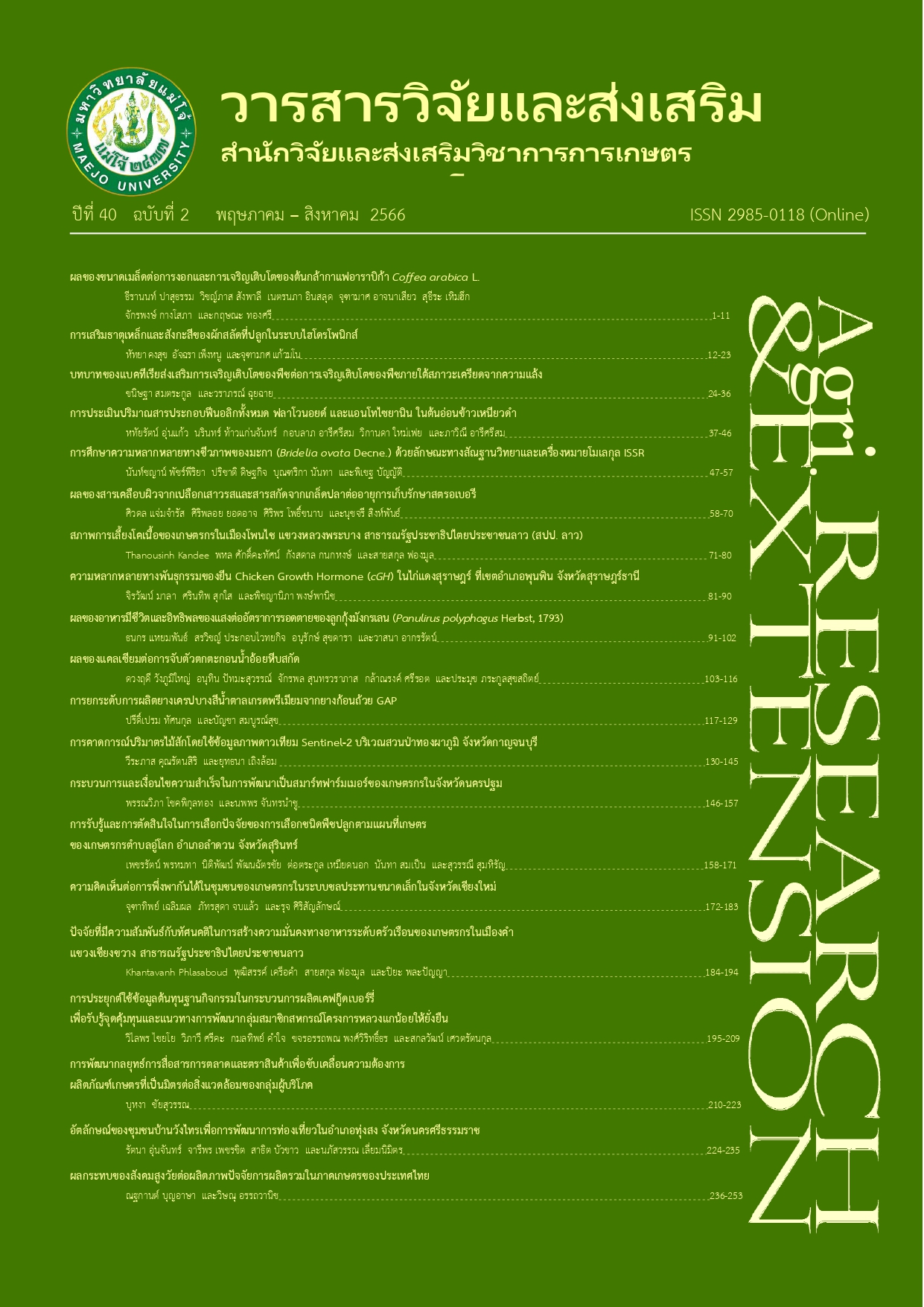ผลของแคลเซียมต่อการจับตัวตกตะกอนน้ำอ้อยหีบสกัด
คำสำคัญ:
น้ำอ้อย, การจับตะกอน, ตกตะกอน, สารประกอบแคลเซียมฟอสเฟต, เทคนิควัดการดูดกลืนแสงด้วยเอฟทีไออาร์บทคัดย่อ
กระบวนการทำใสน้ำอ้อยในการผลิตน้ำตาลทรายดิบเป็นที่รู้จักกันดี อาศัยหลักการจับตะกอนของของแข็งที่ละลายในน้ำอ้อย แล้วทำการตกตะกอนแยกน้ำอ้อยใสออกมา ในงานวิจัยนี้มีวัตถุประสงค์เพื่อศึกษา ผลของแคลเซียมต่อ pH ซึ่งมีผลต่อการจับตะกอนของแข็งที่แขวนลอยในน้ำอ้อย โดยได้นำน้ำอ้อยมาอุ่น ที่อุณหภูมิ 75°ซ. และเติมไลม์แซคคาเรท ซึ่งมีแคลเซียม ไฮดรอกไซด์เป็นองค์ประกอบ เพื่อปรับ pH น้ำอ้อยให้อยู่ในช่วง pH 6.0-8.5 จากนั้นให้ความร้อนจนกระทั่งน้ำอ้อยเดือด นำแต่ละสารละลายตัวอย่างที่ได้ไปเก็บ เพื่อทำการวิเคราะห์เปรียบเทียบกับสารละลายควบคุม จากการทดลองพบว่า ตัวอย่างน้ำอ้อยที่ pH ตั้งแต่ 7.5 เพียงพอสำหรับการจับตะกอนฟอสเฟตที่ 321 มก./กก. กำจัดฟอสเฟตได้ 90.9% มีค่าความขุ่นน้ำอ้อย 0.013 abs โดยพบการสูญเสียซูโครสในปริมาณน้อย ขณะเดียวกันผลจากโปรไฟล์เอฟทีไออาร์ บ่งชี้ว่าในสารละลายมีการเกิดสปีชีหลักของแคลเซียมคาร์บอเนตและแคลเซียมฟอสเฟต แต่ไม่พบในตัวอย่างน้ำอ้อยควบคุม แม้ว่าขนาดอนุภาคเฉลี่ยของสารแขวนลอยไม่แตกต่างกัน
เอกสารอ้างอิง
Berzina, C.L. and N. Borodajenko. 2012. Infrared Spectroscopy – Materials Science, Engineering and Technology. London: IntechOpen. 526 p.
Chen, J.C.P. and C.C. Chou. 1993. Cane Sugar Handbook: A Manual for Cane Sugar Manufacturers and Their Chemists. New York: John Wiley & Sons, Inc. 834 p.
Clarke, D.W., C. Mohtadi and P.S. Tuffs. 1987. Generalized predictive control-Part I: The basic algorithm. Automatica 23(2): 137-148.
Crees, O.L., E. Whayman and A.L. Willersdorf. 1977. Further studies on flocculation. Proc Queensland Soc Sugar Cane Tech 44: 225-232.
Doherty, W.O.S. and L.A. Edye. 1999. An Overview on the Chemistry of Clarification of Cane Sugar Juice. pp. 381-388. In Proceedings -Australian Society of Sugar Cane Technologists. Queensland: Watson Ferguson and Company.
Doherty, W.O.S., J. Greenwood, D. Pilaski and P.G. Wright. 2002. The Effect of Liming Conditions in Juice Clarification. pp. 443-451. In Proceedings-Australian Society of Sugar Cane Technologists. Queensland: PK Editorial Services Pty Ltd.
Doherty, W.O.S. and D.W. Rackemann. 2008. Stability of sugarcane juice a preliminary assessment of the colorimetric method used for phosphate analysis. Sugar Industry 133(1): 24-30.
Doherty, W.O.S. and D.W. Rackemann. 2009. Some aspects of calcium phosphate chemistry in sugarcane clarification. International Sugar Journal 111(1327): 448-455.
Doherty, W.O.S. 2011. Improved sugar cane juice clarification by understanding calcium oxide-phosphate-sucrose systems. J. Agric. Food Chem. 59: 1829-1836.
Eggleston, G. and J.R. Vercellotti. 2000. Degradation of sucrose, glucose and fructose in concentrated aqueous solutions under constant pH conditions at elevated temperature. Journal of Carbohydrate Chemistry 19(9): 1305-1318.
Eggleston, G., A. Monge and A. Pepperman. 2002. Preheating and incubation of cane juice prior to liming: a comparison of intermediate and cold lime clarification. J. Agric. Food Chem. 50: 484-490.
Eggleston, G., A. Monge. 2005. Optimization of sugarcane factory application of commercial dextranases. Process Biochemistry 40(5): 1881-1894.
Eggleston, G., D. Legendre, K. Pontif and J. Goober. 2012. Improved control of sucrose losses and clarified juice turbidity with lime saccharide in hot lime clarification of sugarcane juice and other comparisons with milk of lime. Journal of Food Processing and Preservation 38: 311-325.
Greenwood J., T. Rainey and W.O.S. Doherty. 2007. Light scattering study on the size and structure of calcium phosphate/ hydroxyapatite flocs formed in sugar solutions. Journal of Colloid and Interface Science 306(1): 66-71.
Honig, P. 1963. Principles of Sugar Technology. Amsterdam-London-New York: Elsevier Publishing Company. 767 p.
Istifanus, A.B. 2015. Prediction of Sugar Yield from Sugar Cane Using Process Modeling. Enugu: Department of Agricultural and Bioresource engineering, Faculty of Engineering, University of Nigeria. 17 p.
Johnsson, M.S.A and G.H. Nancollas. 1992. The role of brushite and octacalcium phosphate in apatite formation. Critical Reviews in Oral Biology and Medicine 3(1/2): 61-82.
Karampas, I.A. and C.G. Kontoyannis. 2013. Characterization of calcium phosphates mixtures. Vibrational Spectroscopy 64: 126-133.
Khotaveevattana, S. 2003. Sugar Technology. Bangkok: Department of Product Development, Faculty of Agro-Industry, Kasetsart University. 520 p. [in Thai]
Meejoo, S., W. Maneeprakorn and P. Winotai. 2006. Phase and thermal stability of nanocrystalline hydroxyapatite prepared via microwave heating. Thermochimica Acta 447: 115-120.
Paschalis, E.P., E. DiCarlo, F. Betts, P. Sherman, R. Mendelsohn and A.L. Boskey. 1996. FTIR microspectroscopic analysis of human osteonal bone. Calcif Tissue Int. 59: 480-487.
Phakam, B., L. Moghaddam, M. Wellard and W.O.S. Doherty. 2018. The effect of cleaning agents on the structural features of heat exchanger deposits from sugar factories. Journal of Food Engineering 226: 65-72.
Poel, P.W.V.D., H. Schiweck. and T. Schwartz. 1998. Sugar Technology Beet and Cane Sugar Manufacture. Berlin: Verlag Dr Albert Bartens KG. 1118 p.
Rein, P. 2007. Cane Sugar Engineering. Berlin: Bartens. 768 p.
Seliem, M.K., K. Sridhar and K.R. Mostafa. 2016. Phosphate removal from solution by composite of MCM-41 silica with rice husk: kinetic and equilibrium studies. Journal Microporous and Mesoporous Materials 224: 51-57.
Simpson, R. 1996. The chemistry of clarification. Proc. S. Afr. Sug. Technol. Ass. 70: 267-271.
Steindl, R.J. 2001. Minimizing sugar losses with in-line saccharate mixing. Proc. Int. Soc. Sugar Cane Technol 24: 360-362.
Thai, C.C.D., H. Bakir and W. Doherty. 2012. Insights to the clarification of sugar cane juice expressed from sugar cane stalk and trash. Journal of Agricultural and Food Chemistry 60(11): 2916-2923.
Thai, C.C.D., L. Moghaddam and W. Doherty. 2012. Characterization of sugarcane juice particles that influence the clarification process. pp. 324-332. In Proceedings of the 34th Annual Conference of the Australian Society of Sugar Cane Technologists. Curran Associates, Inc. Mackay: Australian Society of Sugar Cane Technologists (ASSCT).
Thai, C.C.D., L. Moghaddam and W. Doherty. 2015. Calcium phosphate flocs and the clarification of sugar cane juice from whole of crop harvesting. Journal of Agricultural and Food Chemistry 63(5): 1573-1581.
Zaeib, M.G. 2004. The Use of Locally Produced Lime for Clarification of Juice in the Cane Sugar Industry. Master Thesis. University of Al Baath. 136 p.
ดาวน์โหลด
เผยแพร่แล้ว
รูปแบบการอ้างอิง
ฉบับ
ประเภทบทความ
สัญญาอนุญาต
ลิขสิทธิ์ (c) 2023 วารสารวิจัยและส่งเสริมวิชาการเกษตร

อนุญาตภายใต้เงื่อนไข Creative Commons Attribution-NonCommercial-NoDerivatives 4.0 International License.
บทความนี้ได้รับการเผยแพร่ภายใต้สัญญาอนุญาต Creative Commons Attribution-NonCommercial-NoDerivatives 4.0 International (CC BY-NC-ND 4.0) ซึ่งอนุญาตให้ผู้อื่นสามารถแชร์บทความได้โดยให้เครดิตผู้เขียนและห้ามนำไปใช้เพื่อการค้าหรือดัดแปลง หากต้องการใช้งานซ้ำในลักษณะอื่น ๆ หรือการเผยแพร่ซ้ำ จำเป็นต้องได้รับอนุญาตจากวารสาร





